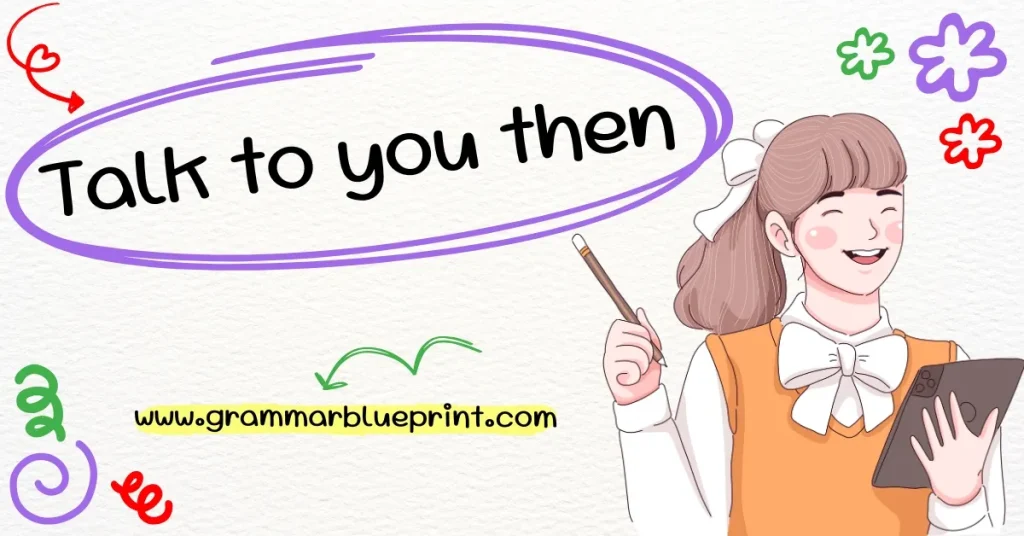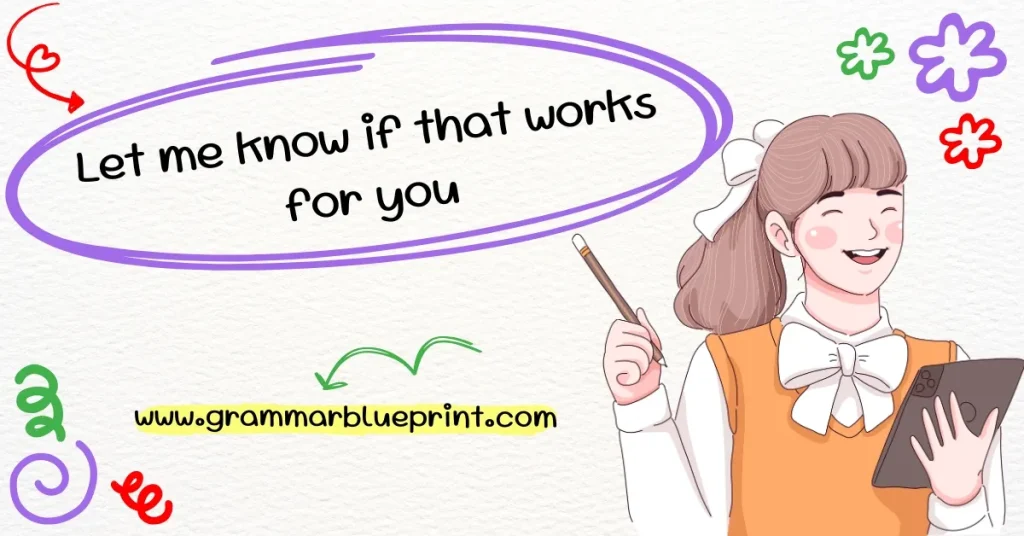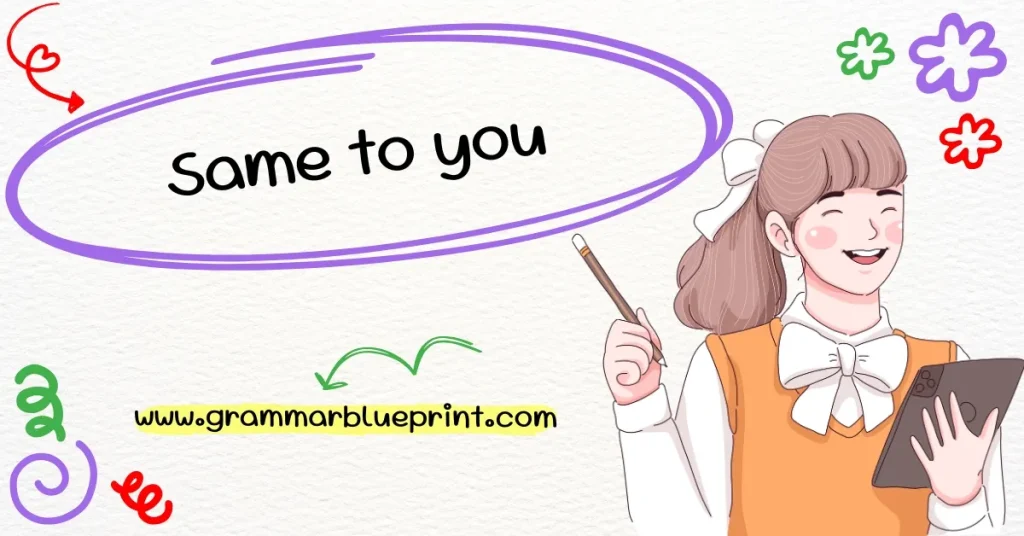In English, expressing how we end a conversation can vary depending on the context. One such phrase that comes up often is “Talk to you then.” It’s a casual and friendly way to close a conversation and is widely used in both personal and professional settings. In this blog, we’ll explore its meaning, usage, and alternatives to help you communicate confidently and effectively in English.
What Does “Talk to You Then” Mean?
“Talk to you then” is a casual, informal phrase used when saying goodbye or ending a conversation, typically indicating that you will speak to someone again in the future. It’s a way of expressing future interaction without setting a specific time. This phrase conveys a sense of closeness and continuity, suggesting that the conversation will be picked up at a later date or time.
In context, it is used to show that the conversation will be resumed soon, even if the exact time isn’t specified. You may hear this when people are signing off from a chat, a phone call, or a meeting.
For example, you might say, “I’ll talk to you then” after scheduling a call for the next day or after saying goodbye to a friend, indicating that you’ll be in touch soon. The tone of the phrase is generally warm and friendly, creating a sense of anticipation without making things feel too formal or rigid.
When to Use “Talk to You Then”
The phrase “Talk to you then” can be used in a variety of situations. Typically, it’s used to close a conversation or make arrangements to talk at a later time.
- Informal Settings: You can use it with friends, family, or anyone you have a casual relationship with. It’s often heard after a brief chat or when setting a time to talk again.
Example: “Okay, I’ll talk to you then! Have a good day!” - Professional Settings: While it’s more casual, it can also be appropriate in professional emails or messages when you don’t need to be overly formal. For instance, after scheduling a meeting or call, you might end the conversation with “Talk to you then” as a friendly sign-off.
Example: “Thanks for the meeting today, I’ll talk to you then regarding the next steps.”
The phrase is most often used when the exact time or date for the next conversation is uncertain, but it implies that communication will continue at some point in the near future.
Benefits of Using “Talk to You Then” in English
Using “Talk to you then” in your conversations offers a few key benefits that make it both practical and effective for communication:
- Expresses Future Plans or Intentions: This phrase is great for letting someone know that you’ll be in touch again soon. It’s an easy way to express that you intend to continue the conversation without specifying a precise time.
- Adds a Conversational Tone: Unlike more formal phrases like “Goodbye” or “See you later,” “Talk to you then” keeps things light and informal, contributing to a friendly and open conversation. It signals that you’re comfortable speaking with the person and plan to do so again soon.
- Makes Conversations Feel More Natural: It’s a great way to end a conversation in a manner that doesn’t feel abrupt or stiff. It smooths over the end of a discussion and leaves the door open for future communication.
By integrating phrases like “Talk to you then” into your conversations, you’ll enhance the natural flow of dialogue and make your speech more engaging and approachable.
How to Use “Talk to You Then” Correctly
Using “Talk to you then” correctly is simple, but there are a few things to keep in mind to make sure you’re using it appropriately:
- Know Your Audience: This phrase is informal, so it’s most suitable for casual conversations. While it can be used in professional settings, it’s important to be mindful of the tone and the relationship you have with the person you’re speaking to. In more formal settings, you might want to opt for other phrases like “I look forward to speaking with you” or “We’ll talk soon.”
- Use It for Future Interactions: The phrase is used when you expect to talk to someone again, but the timing isn’t set. It’s ideal when you want to express that you’ll speak again soon, but the conversation doesn’t need to be planned out in detail.
- Vary the Phrasing: You can alter the phrase slightly depending on the situation:
- “I’ll talk to you then”
- “We’ll talk soon”
- “I’ll speak with you then”
- “I’ll talk to you then”
Each variation gives a slightly different tone or level of formality, but all communicate the same idea of continuing the conversation later.
- Avoid Overuse: As with any expression, it’s important to use “Talk to you then” naturally. Overusing it may make it sound repetitive. Instead, mix it up with other phrases that suit the situation.
Examples of “Talk to You Then” in Different Contexts
Everyday Conversation
In informal contexts, this phrase is often used among friends, family, or colleagues who are having a casual chat. It’s a way of saying goodbye while indicating that you’ll talk again soon.
Example: “Alright, I’m heading out now. Talk to you then!”
Professional Settings
While more casual than formal, “Talk to you then” can still be used in professional communications, such as emails or during a business call.
Example: “Thanks for your input today. I’ll talk to you then for our next meeting.”
Text Messages and Emails
In digital communication, this phrase can help wrap up a conversation smoothly. It signals that the conversation will continue without being abrupt.
Example: “Thanks for the update. Talk to you then!”
Video Calls or Phone Conversations
During phone or video calls, “Talk to you then” can be used to politely end the conversation while implying future communication.
Example: “Alright, I’ve got to go now. Talk to you then!”
Better Alternatives to Say “Talk to You Then”
While “Talk to you then” is a popular and useful phrase, there are plenty of other expressions you can use to convey a similar message. Here are some common alternatives to keep your conversations fresh and engaging.
1. Catch You Later
Meaning: Informal way of saying goodbye, with a promise to connect again soon.
Best Use: Casual conversations with friends or acquaintances.
Tone: Friendly, relaxed.
2. See You Soon
Meaning: Implies that you will see the person in the near future.
Best Use: Used after setting a meeting or in casual interactions.
Tone: Warm, casual.
3. Talk Soon
Meaning: A friendly way of saying you’ll talk again shortly.
Best Use: Used after a phone call or casual meeting.
Tone: Informal, positive.
4. Speak to You Later
Meaning: Indicates that you will talk again at a later time.
Best Use: Used in both casual and semi-formal settings.
Tone: Friendly, polite.
5. Catch You on the Flip Side
Meaning: A fun, playful way to say goodbye.
Best Use: Very informal, used with friends or close colleagues.
Tone: Fun, informal.
6. I’ll Be in Touch
Meaning: A more formal way to say you’ll communicate again.
Best Use: Suitable for work emails or professional communication.
Tone: Polite, professional.
7. Talk to You Shortly
Meaning: Indicates that you’ll talk again in the near future, but with a shorter timeframe implied.
Best Use: After setting up a short-term follow-up.
Tone: Neutral, courteous.
8. Chat Later
Meaning: Informal expression for saying goodbye with an implication of chatting again soon.
Best Use: Casual text or phone conversation.
Tone: Friendly, informal.
9. See You Later
Meaning: A common and simple way to say goodbye, often used with the expectation that you will meet or talk again soon.
Best Use: Casual conversations, especially among friends or family.
Tone: Friendly, informal.
10. Speak to You Soon
Meaning: A polite way of saying that you will talk to the person again in the near future.
Best Use: Can be used in both casual and semi-formal settings, including text messages and phone calls.
Tone: Neutral, polite.
11. Until Then
Meaning: A way to say goodbye, indicating that you’ll be in touch at a later time, without specifying exactly when.
Best Use: Ideal for casual conversations where a future discussion is expected, but no exact time is set.
Tone: Neutral, informal.
12. Catch You on the Flip Side
Meaning: An informal, playful way to say goodbye, implying that you’ll talk again when circumstances change, such as after a break or the next time you meet.
Best Use: Casual interactions, often used with close friends or colleagues who share a relaxed relationship.
Tone: Fun, light-hearted.
13. I’ll Be in Touch
Meaning: A polite way of saying that you’ll contact the person again soon, often used in more formal or professional settings.
Best Use: Professional emails or conversations where the next communication is implied but not specified.
Tone: Professional, polite.
14. Talk to You Shortly
Meaning: A way of saying goodbye with the implication that you will speak to the person again very soon, usually within a short time frame.
Best Use: Used when scheduling another quick conversation, like after a meeting or phone call.
Tone: Neutral, courteous.
15. Talk Later
Meaning: A casual way to say goodbye, signaling that the conversation will continue later.
Best Use: Everyday interactions, either in person or in texts.
Tone: Informal, friendly.
16. I’ll Catch Up With You Then
Meaning: A casual way to say goodbye while implying that you’ll reconnect soon to continue the conversation.
Best Use: Used when you want to indicate that you will revisit the discussion at a later time.
Tone: Informal, conversational.
17. We’ll Talk Soon
Meaning: A friendly way of saying goodbye with an expectation that the conversation will continue soon, often used between people who have an ongoing dialogue.
Best Use: Casual settings, between friends or close colleagues.
Tone: Friendly, informal.
18. Talk to You When the Time Comes
Meaning: A way to express that you will speak again at an appropriate or agreed-upon time, though the exact timing is vague.
Best Use: In more formal or strategic discussions where the follow-up conversation is anticipated, but the timing is flexible.
Tone: Neutral, polite.
19. I’ll Check In With You Soon
Meaning: A polite, slightly more formal way to say that you’ll contact the person again soon.
Best Use: Suitable for professional conversations or when you want to show that you will follow up after a meeting or call.
Tone: Professional, polite.
20. I’ll Get Back to You Then
Meaning: A way to end a conversation, indicating that you will respond to the person’s request or continue the discussion at a later time.
Best Use: Used in professional settings where a follow-up or further response is expected.
Tone: Professional, formal.
21. Talk to You in a Little While
Meaning: A casual way to indicate that you will reconnect with someone in the near future.
Best Use: Casual conversations, especially in texting or messaging.
Tone: Friendly, informal.
22. Until Then
Meaning: A simple way to say goodbye, implying you’ll be in touch or see the person again soon.
Best Use: Casual or informal settings where the time for the next interaction is unspecified but expected soon.
Tone: Casual, relaxed.
23. I’ll Chat With You Later
Meaning: A casual, friendly way to say that you’ll speak again in the future, typically after the current conversation has ended.
Best Use: Casual, informal interactions, especially when talking to friends or family.
Tone: Friendly, informal.
24. I’ll Connect With You Later
Meaning: A more neutral way to say goodbye, indicating that you’ll be in touch at some point in the future.
Best Use: Used in both casual and professional settings when you need to end a conversation but anticipate future communication.
Tone: Neutral, polite.
25. I’ll Call You Then
Meaning: A way to end a conversation with the intention to call again at a later time.
Best Use: Casual conversations where a phone call or future follow-up is planned.
Tone: Informal, friendly.
26. We’ll Speak Then
Meaning: Similar to “Talk to you then,” this phrase implies that you’ll have a conversation at a later time.
Best Use: Often used in professional or semi-formal contexts, especially in business settings.
Tone: Professional, polite.
27. Let’s Talk Later
Meaning: A friendly way to indicate that a conversation will continue at a later time.
Best Use: Used in casual conversations or when there’s a need to end a discussion but pick it back up soon.
Tone: Friendly, informal.
28. I’ll Reach Out to You Then
Meaning: A more formal way of saying that you will contact the person again in the future.
Best Use: Ideal for professional settings where future communication is expected, often used in emails or official conversations.
Tone: Professional, polite.
29. See You Then
Meaning: A simple way to say goodbye, implying that you’ll meet or talk to the person at a later time.
Best Use: Can be used in both casual and professional settings, depending on the context.
Tone: Friendly, neutral.
30. Talk to You Soon
Meaning: An informal expression that indicates you’ll continue the conversation in the near future.
Best Use: Casual conversations, especially between friends, family, or colleagues you speak with regularly.
Tone: Friendly, informal.
Tips for Using Phrases Like “Talk to You Then” in English
To use phrases like “Talk to you then” confidently, keep the following tips in mind:
- Focus on Tone and Formality: Depending on whether you’re in a casual or formal setting, the tone of your phrase should match the level of formality required.
- Understand the Context: Know when it’s appropriate to use more casual phrases like “Talk to you then” and when a more formal phrase might be better.
- Practice with Native Speakers: Engage in conversations with native English speakers to get comfortable using these expressions in real-world situations.
Common Mistakes with “Talk to You Then”
- Misusing in Formal Contexts: “Talk to you then” is informal, so avoid using it in formal business emails or official correspondence.
- Confusing with Similar Phrases: Don’t confuse “Talk to you then” with other similar phrases like “Talk to you later” or “See you soon.” Understand the subtle differences in their usage.
- Overuse of Informal Expressions: Overusing casual expressions can make your speech sound less professional or insincere. Be mindful of context.
How to Practice Using “Talk to You Then” in Conversations
- Role-Playing Scenarios: Practice with a partner in different contexts—both formal and informal.
- Use Language Apps: Apps that simulate real-world conversations can help you practice using phrases like “Talk to you then.”
Conversational Practice: Engage in practice conversations with peers, teachers, or tutors to refine your skills.



